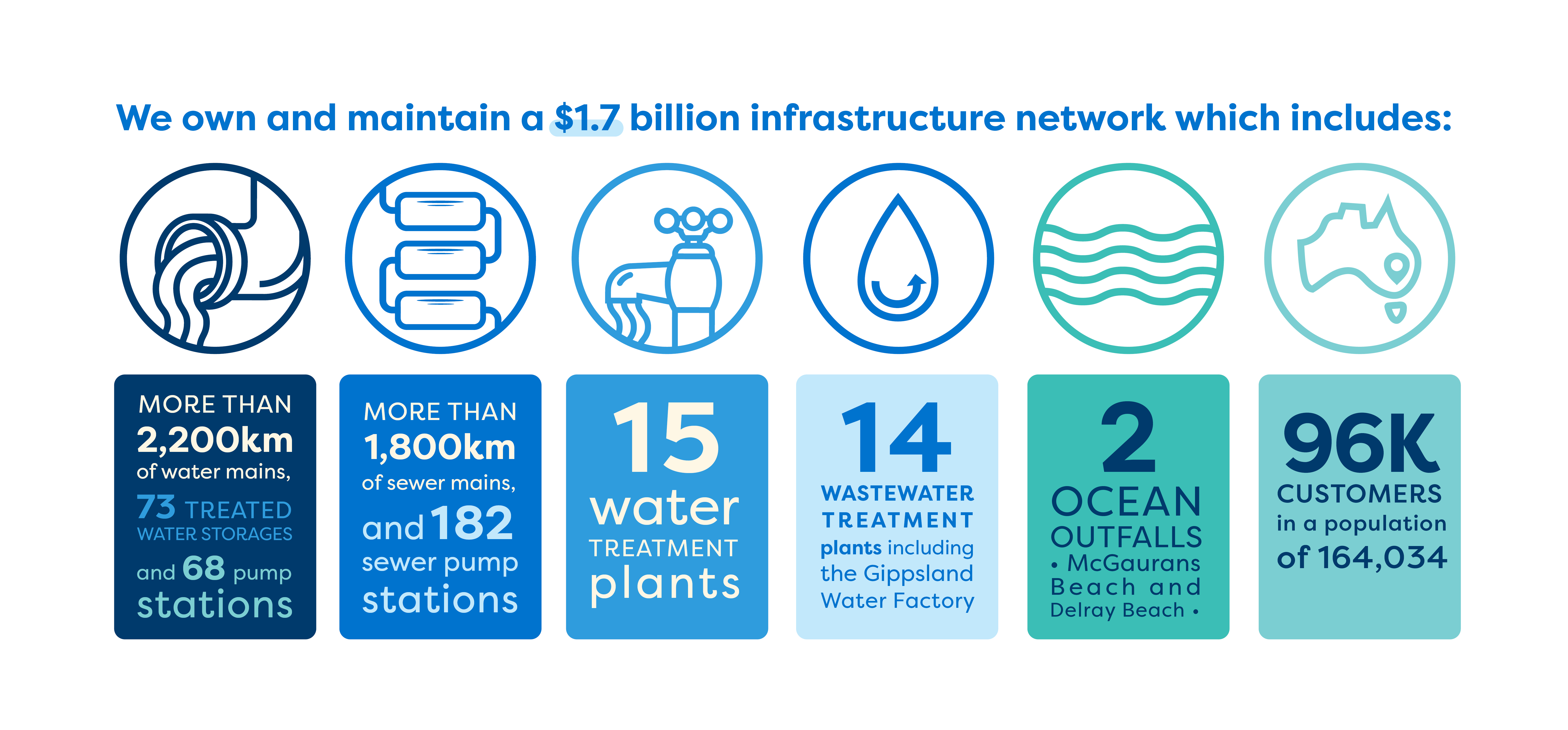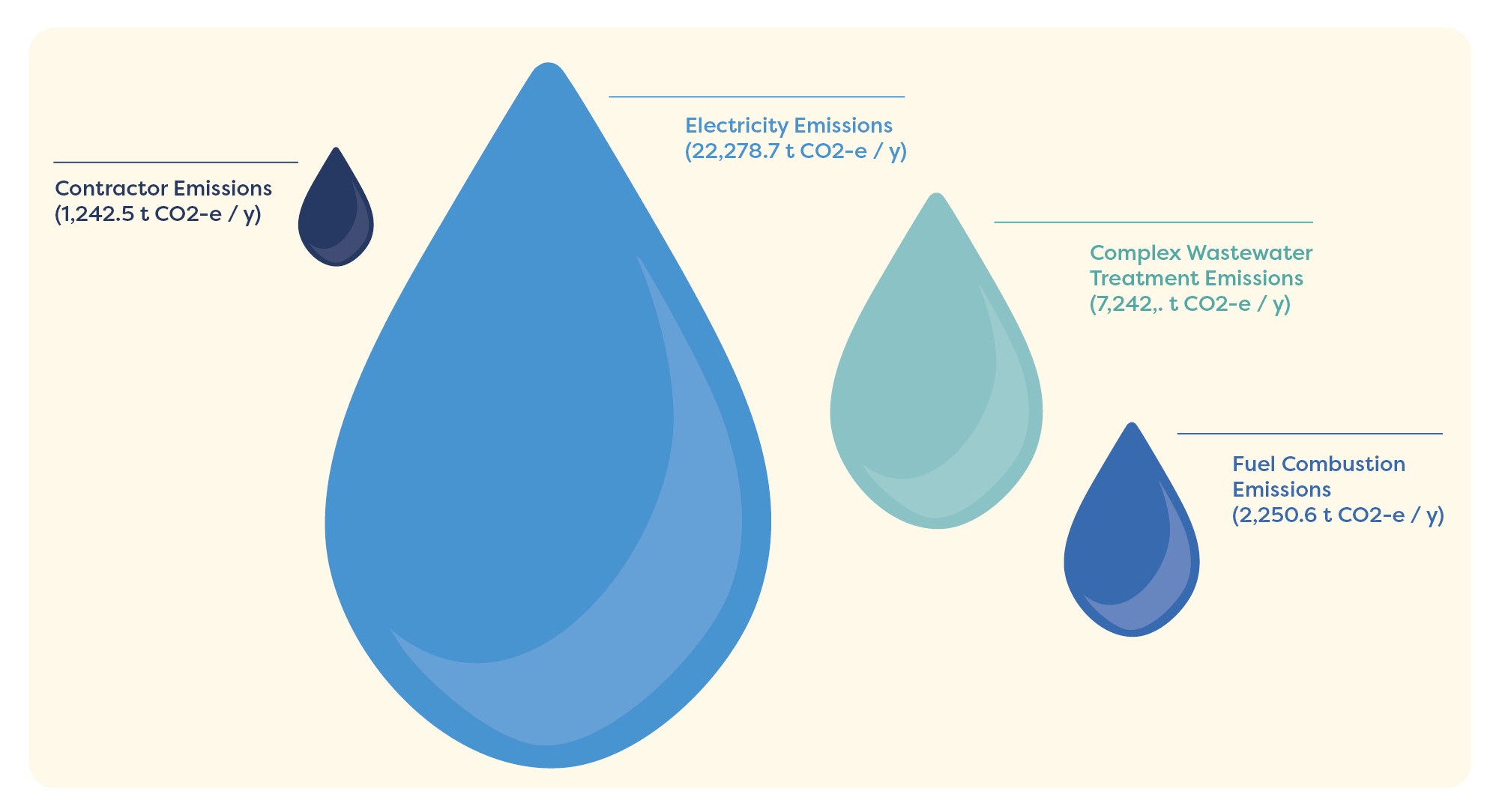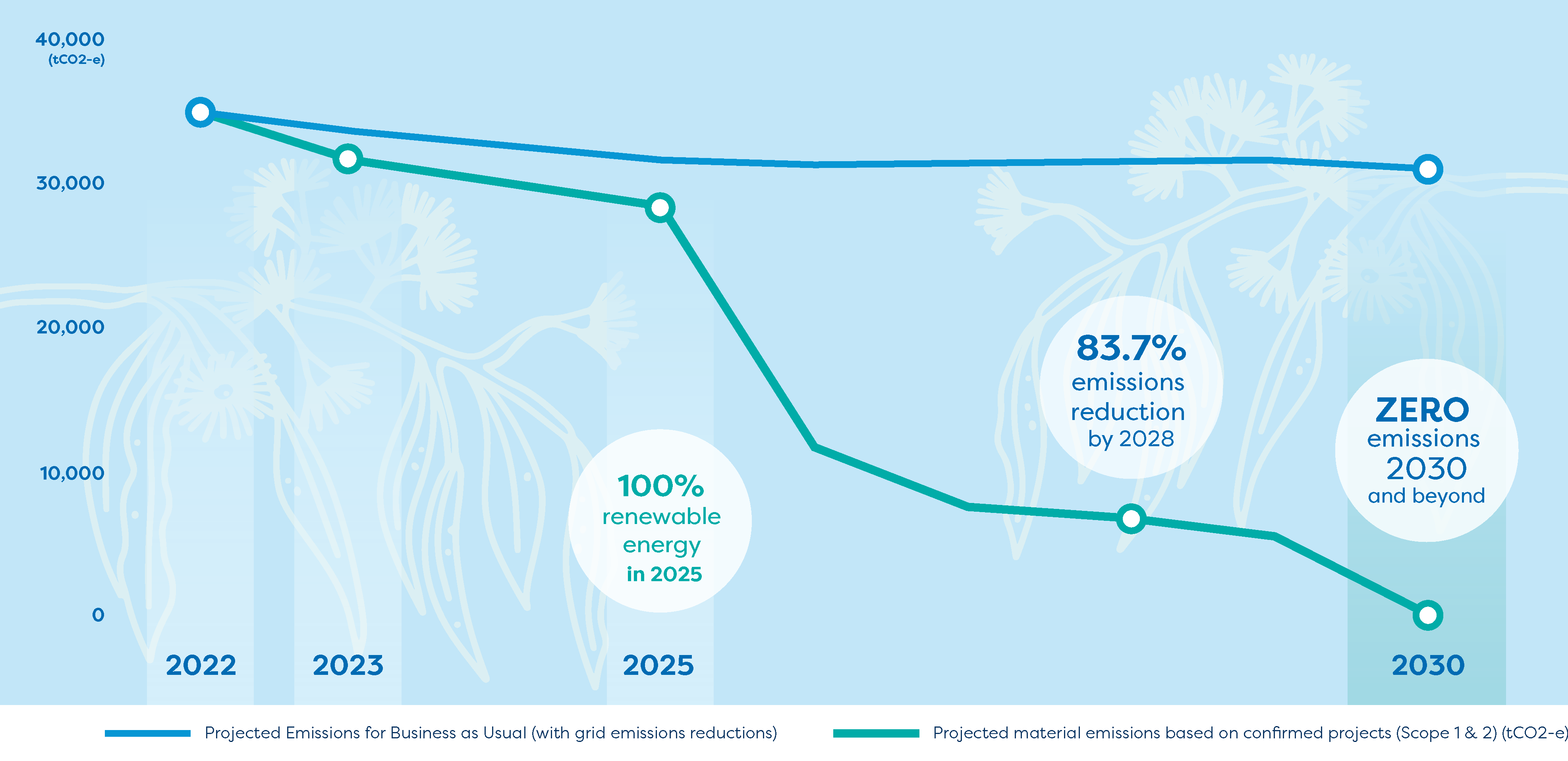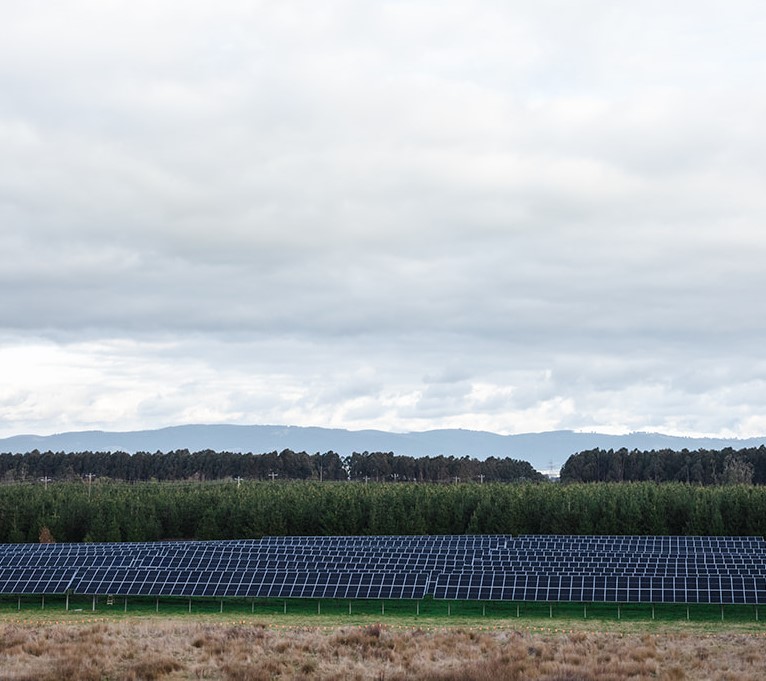Jump to topic
Download Climate Change Strategy
We published our first Climate Change Strategy in 2017 which laid a pathway to net zero emissions by 2050.
This renewed strategy builds on our success so far, and sets ambitious, yet achievable new targets to achieve 100% renewable energy driven operations by 2025 and net zero emissions by 2030 – 20 years earlier than originally planned.
Introduction
Acknowledgement of Country
We acknowledge the Traditional Owners of the land we work on, the Gunaikurnai people and the Bunurong people, and recognise their strong cultural connection to the land and waterways.
We pay our respect to their Elders, past and present.

Learning from our shared history
Archaeological evidence of Aboriginal peoples living in what is now Victoria dates back at least 30,000 years and possibly up to 40,000 years before present day. Over this period, Australia’s climate has changed markedly with the Last Glacial Maximum occurring between 27,500 and 23,000 years ago and many other challenging climatic events occurring before and after.
These changes in climate had profound effects on the landscape, seascape, ecology, and in-turn, the peoples surviving here. Yet, the ancestors of those who lived through those events remain here today. As the longest continuously surviving culture on Earth, Australia’s Aboriginal peoples are the ultimate success story for climate change adaptation. While the changes they experienced were natural, the measures they no-doubt took to adapt to those changes were almost certainly akin to many of the measures we need to take to rise to the contemporary, anthropogenic, climate challenges we face today.
One of the many Dreaming stories telling of climate-related changes and challenges experienced by Gunaikurnai people of our region is Tidilick.
Tidilick
Long ago there was a big frog and his name was Tidilick. He went to the river to have a drink. He began to drink the water from the water hole, then from the creek, then the river, ‘til there was nothing left.
All the animals were thirsty. There was no water anywhere.
The animals called a meeting, they decided that one of them should try to make Tidilick laugh. Turtle and platypus played leapfrog. That didn’t make Tidilick laugh. Duck and bird flew around. That didn’t make Tidilick laugh. Bataluk strutted to and fro puffing out his stomach. Tidilick was nearly asleep. Snake said, ‘Let me try’. He started a wiggly, squiggly dance. He twisted and nearly tied himself in
a knot.
Then came a rumbling noise from Tidilick and it grew louder and louder. His mouth opened and he began to laugh. A mighty gush of water came out of his mouth, all the water came back to the water holes and the rivers.
“Tidilick tells of the natural history of the area and the flood records the period of natural change. It shows the location of Lurtbit Yauung Brataualung clan group who recorded this story. It shows the natural history of the country going through a turbulent time of great natural change, which shaped the landscape as we know it today.”
We thank the Gunaikurnai Land and Waters Aboriginal Corporation (GLaWAC) Elders and Knowledge Holders for approving the use of the Tidilick story.

A message from our Managing Director
I’m proud to present our 2024 Climate Change Strategy.
As an essential services provider delivering drinking water and wastewater services to about 164,000 people across Gippsland, climate plays a big role in what we do.
There is no doubt it is changing and the impacts are already being felt across every part of our business.
More extreme weather events put more pressure on our systems, leading to more interruptions and hinder our ability to get projects done on time.
How we respond, adjust and adapt is critical, which is where this plan comes into play.
Climate change planning isn’t new to us. For many years, we’ve been undertaking comprehensive modelling to understand what’s happening and where we need to adjust. We’ve also spoken with our customers to find out what they think and expect of us.
In short, they want us to plan for the future; invest in climate resilience; be good environmental stewards and protect our scarce resources for future generations. At the same time, they want us to keep prices fair and take care of those who struggle to pay their bills.
Investment in more renewable energy is one of the points where these two critical objectives come together.
Managing water and wastewater services across such a big and diverse area as ours takes a lot of power; and that power comes at a massive cost.
We’ve been investing in renewable energy for a pretty long time now and what we’ve learnt is that it can dramatically reduce our power bill. That means reducing our overall operating costs which ultimately allows us to put downward pressure on customer bills.
For these reasons and others, we’re committed to achieving some pretty ambitious emissions and renewable energy targets.
Those targets are that all of our operations will be powered by renewable energy by 2025 and we’ll reach net zero emissions 2030; and we’re on track to meet both.
Tackling climate change will involve a combination of engineering solutions, strategic thinking, technological improvements and behavioural changes.
Innovation in the way we think, plan and engineer is essential. That includes exploring and developing ways to potentially capture and use energy within our systems.
We’ll measure and track our performance and report back to customers with how we’re doing and to also seek their feedback.
While no single policy or plan will solve the challenges climate change poses on its own, this strategy brings together the various things we’ll be doing to prepare, respond and adapt so that our customers can continue to rely on us to provide safe and reliable services for decades to come.


About Us
Our service area covers 5,000 square kilometres and stretches from Drouin in the west to Loch Sport in the east, and from Mirboo North in the south to Rawson and Briagolong in the north. This includes municipalities of Latrobe City, Baw Baw, South Gippsland and Wellington shire councils.
About this strategy
About our Climate Change Strategy
We published our first Climate Change Strategy in 2017 which laid a pathway to net zero emissions by 2050.
Since then, our understanding of the critical role that the water industry plays in climate change mitigation and adaptation has deepened. Our actions are essential to ensuring our business, staff, infrastructure, and natural resources are as resilient as possible to the changes in climate we expect to experience.
This renewed strategy builds on our success so far, and sets ambitious, yet achievable new targets to achieve net zero emissions by 2030 – 20 years earlier than originally planned.
How we developed this Strategy
Our Strategy has been developed with in-depth knowledge and understanding of how the latest scientific research applies to our business and region.
We’ve consulted with internal and external stakeholders to gather information and extend our knowledge.
From this, we identified the top 20 risks that climate change poses to our business.
These risks cover four broad subjects across our operations and services:
- Emissions accounting and reduction
- Impacts on infrastructure
- Capacity constraints
- Natural resources and cultural values
By understanding the magnitude and control we have over these risks, we’ve set achievable short and long-term actions and targets. The foundations of this Strategy strongly align with our vision and Strategic Priorities Framework to provide a healthy and sustainable Gippsland for generations to come.
Why take action on climate change?
The Victorian water sector emits roughly a quarter of government-based emissions. As a medium sized water corporation, we play an important role in fighting climate change, and we’ll do so through urgent and transformative action.
Policy and Legislation
The Paris Agreement
The Paris Agreement is the global plan to keep temperature increases well below 2°C above pre-industrial levels.
The Climate Change Act 2017
The Victorian Government’s Climate Change Act 2017 provided the legislative foundations to manage climate change risks, maximise the opportunities that arise from decisive action, and drive a more climate-resilient Victoria.
Victoria’s Climate Change Strategy 2021
In May 2021, growing awareness around the urgency to act on climate change led to development of the first Victorian Climate Change Strategy. This strategy committed to ensuring all Victorian Government operations (including water businesses) would source 100% of their electricity from renewable sources by 1 January 2025.
Statement of Obligations – Emissions Reduction 2022
In October 2021, our Board endorsed a more ambitious target of net zero by 2030. With emissions from electricity set to be zero by 2025, it was a realistic opportunity to have a target to reduce our emissions 20 years earlier than our original target of net zero by 2050. With Executive and Board endorsement, this target was formally adopted in the new Statement of Obligations (Emissions Reduction) in May 2022.
Water for Victoria 2016
The Water for Victoria – Water Plan was developed by the Victorian Government and released in late October 2016. The Plan sets the strategic direction for water management over the coming decades with a significant focus on sustainably managing climate change and population growth.
Our Climate Strategy on a global scale |
|||||
|---|---|---|---|---|---|
| How our Climate Change Strategy sits within the global, national and state frameworks for climate change action. | |||||
| Global | Australia | Victoria | Victoria Water Industry | Us, Gippsland Water | |
| Framework | Paris Agreement | Emissions reduction target | Climate Change Act 2017 | Water for Victoria & Statement of Obligations (emissions reduction) | Climate Change Strategy 2023 |
| Target | Limit the increase in global average temperature to 1.5 - 2 Degrees Celsius above pre-industrial levels. | Net zero greenhouse gas emissions by 2050. | Net zero greenhouse gas emissions by 2045. | Net zero greenhouse gas emissions by 2035. | Net zero greenhouse gas emissions by 2030. |
| Key messages | By 2030 they aim to reach emission levels of 43% below 2005 levels. |
Rolling emissions reduction targets set on a five-year basis. Consistent with the Paris Agreement. |
Each water corp and CMA pledge rolling emissions reduction targets on a five-year basis. |
Five yearly pledges. Energy Management Strategy 2022. Carbon offset program. |
|
Our future climate
Australia's climate has already warmed by approximately 1.47 Degrees Celsius since 1910. As a result of this warming, our region can now expect:
Victorian Climate Change Projections |
||||||
| 2025 | 2030 | 2035 | 2040 | 2045 | 2050 | |
| Confidence level | Very high | Very high | Medium to high | Low to medium confidence | High confidence | High confidence |
| Gippsland Climate Change Projections | Increasing maximum and minimum daily temperatures. | Increases in daily maximum temperature of 0.9 to 1.8 Degrees Celsius (since the 1990's). | Over the long term, declining rainfall in winter and spring. | Over the long term, declining rainfall in autumn. | More intense extreme rainfall events on average (across the century) | The climate of Traralgon could be more like the current climate of Bairnsdale. |
Increase in temperature is the primary driver of many of the extreme events we expect to experience in the future.
Higher temperatures are likely to drive average water consumption up with gardens, lawns, parks and recreation reserves requiring more water, more frequently.
This scenario has the potential to put strain on our water supply reservoirs and catchments, as well as the reticulation network.
Our approach
Our approach to climate change
Mitigation and adaptation
Climate change action is typically divided into two categories: adaptation and mitigation.
Mitigation focuses on dealing with the causes of climate change by reducing global greenhouse gas emissions.
Some mitigation examples in the water sector include:
- Using renewable energy to power water and wastewater treatment.
- Improving energy efficiency in water supply and treatment
- Capturing biogas from wastewater treatment to produce electricity.
Adaptation focuses on living and coping with the impacts of climate change.
Some adaptation examples in the water sector include:
- Ensuring our water infrastructure is resilient to climate change.
- Using more recycled water and storm water on green spaces.
- Building resilience to more extreme weather events impacting water services.
Some climate change actions involve both adaptation and mitigation activities.
Some examples of mitigation and adaptation being used cohesively in the water sector include:
- Planting trees to improve water quality and reduce greenhouse gases.
- Converting organic waste from sewerage treatment to energy.
- Water conservation and efficiency.
Mitigation
Climate Change Mitigation – Removing our contribution to the problem
Our emissions
Two-thirds of our yearly emissions come from electricity consumption. Approximately one quarter comes from wastewater treatment and less than one-tenth comes from all sources of fuel combustion.
- Scope 1 Emissions - Combustible fuels (stationary plant, vehicle fleet and mains natural gas)
Emissions from this category average around 2,000 tCO2-e per annum. - Scope 1 Emissions - Wastewater treatment
Our emissions from this category average around 8,700 tCO2-e per annum. Significant fluctuations can occur from lagoon desludging events where emissions have reached as high as ~15,000 tCO2-e per annum. - Scope 2 Emissions – Electricity consumption
Over the past five years, our electricity-related emissions have averaged approximately 25,000 tCO2-e per annum. - Contractor emissions
On average, our contractor emissions amount to approximately 1,200 tCO2-e per annum.

There is a lot of work to achieve and sustain net zero from 2030 and beyond. If we don’t keep pace with change we may realise several unacceptable risks such as an exponential increase in offset costs and increasing insecurity of offset sources. Figure F shows expected emissions beyond 2025 in a scenario where no further emissions reductions initiatives are implemented beyond that year. This is why it’s so critical that we act now on climate change.

Our progress so far
Already we have:
- Almost doubled our renewable energy production from 2,806 MWh per year in 2017 to 5,451MW per year in 2022.
- Planted more than 200,000 native plants at our property at Dutson Downs. As they grow, these plants will remove approximately 60,000 tonnes of carbon from the atmosphere.
- Added new technology to the Gippsland Water Factory including two 330kW biogas generators, a 385kW hydroelectric generator and a 1.3 MW solar installation.
- Developed an Energy Management Strategy, which identifies strategic options for energy cost reduction, including investment in energy generation. This Strategy and renewable energy investment has seen our emissions from electricity consumption fall by 18% over 5 years – from 28,161 tCO2-e in 2017 to 23,829 tCO2-e in 2022 – all while continuing to grow our business and deliver consistent services to our customers.
- Started to replace our fleet with hybrid-electric and wholly electric vehicles.
Case study: Solar at Gippsland Water Factory
We’ve installed solar arrays at our highest energy consuming sites including many water and wastewater treatment plants.
The most recent project installed more than 2,000 solar panels at our Gippsland Water Factory.
The 1,280-kilowatt system produces enough energy to power over 400 Victorian households and at its peak capacity it has the potential to generate enough electricity to completely power the factory.
This renewable generation project has delivered environmental and financial savings, and is a major contributor towards our commitment to make our operations 100% renewable powered by January 2025.

Emissions accounting and reduction risks
- Policy and / or regulatory changes affect planned mitigation and adaptation actions.
- Scope 3 (or otherwise unreportable) emissions become reportable resulting in increased emissions liabilities.
- Protracted continuation or increase of avoidable emissions.
- Inadequate sources of carbon offsets available to meet future requirements.
- Missed opportunities to develop and support new industries and attract external funding and resources to manage climate change risks.
What we plan to do
Investment in renewable energy
- Explore additional renewable energy production across our sites including solar, hydro, biogas and wind.
- Implement our new Energy Management Strategy to improve our energy efficiency across the business and help us hit our 2025 target of acquiring 100% of our electricity from renewable sources.
Carbon Sequestration
- Develop a Carbon Offset Plan and identify additional sites for large scale environmental plantings for carbon sequestration.
- Continue to investigate a collective approach with other water corporations to secure carbon credits in Victoria.
Policy and Procurement
- Continue to be actively involved in industry forums, regulation and policy development and other key networks to influence and remain abreast of policy or regulatory shifts.
- Update our fleet policy to reflect our new targets and develop a plan to transition to a zero emissions fleet.
- Continue to strengthen accounting and reporting methods for greenhouse gas emissions for increased data confidence.
- Develop guidelines for purchasing that put downward pressure on contractor emissions liabilities that we inherit.
- Update business case templates to consider and address climate change mitigation and adaptation risks for all new proposed projects.
Develop ‘Electrify Everything’ Plan
The Electrify Everything plan will:
- Coordinate to reduce and remove Scope 1 emissions from sources that are readily replaceable with electric alternatives.
- Identify the energy consuming sources of Scope 1 emissions remaining in our business (such as generators, building heating, hot water heating, stoves, barbecues, chainsaws, and other similar fixed and mobile appliances [excluding vehicles – which are addressed separately]).
- Develop a detailed and costed timeline to switch these sources to electric alternatives that will remove all feasible sources of Scope 1 emissions by 2030.
Zero emissions transport
- Commit to an end date for internal combustion engines (ICE), including our passenger fleet, light commercial and heavy commercial vehicles.
- This includes upgrading infrastructure like charging stations to facilitate the increase in electric vehicles at our office and other locations.
When we achieve this goal we expect to deliver a saving of in the order of 1,200 tCO2-e per annum. This will also streamline and simplify our emissions reporting requirements.
Adaptation
Climate Change Adaptation
Building our resilience
Adapting to climate change is adjusting to current or expected climate change and its effects. This means we must anticipate, manage and invest in adapting to the resulting climate risks and impacts to our area.
Risks
Impacts on infrastructure
- Damage to infrastructure from soil movement
- Increased risk of flash flooding damaging infrastructure, soils and the natural environment
- Inundation and erosion of coastal assets and infrastructure
- Increased severity and frequency of bushfires.
Capacity constraints
- Water infrastructure malfunctioning during extreme heat events.
- Wastewater infrastructure malfunctioning or performing poorly during extreme weather events.
- Inadequate emergency preparation and response to internal and external events.
- Impacts of extreme weather and chronic climate change on employee health and wellbeing.
Natural resources and cultural values
- Increased frequency and distribution of harmful and nuisance algal blooms.
- Geographic migration and / or increased prevalence of harmful pests and pathogens currently found in warmer climates.
- Decline in ecological health of waterways.
- Decline in health and productivity of farming operations.
- Loss or damage to artefacts, sites or the natural environment with cultural significance to Traditional Owners and Aboriginal Victorians.
- Reduced quality and reliability of water supplies to our customers.
- Loss of biodiversity and ecosystem resilience.
Case study: Tweed Shire Council – Building Back Better
The Tweed Shire Council is responsible for water and wastewater services in north-east New South Wales. In 2017, the area experienced significant and widespread flooding that impacted the Council’s ability to maintain water and waste services. Much of their infrastructure was inundated or damaged and required replacement.
Rather than replacing their assets in a like-for-like fashion, they conducted a critical assessment of the appropriateness of those assets in those locations, and where there were found to be future risks from similar or worse floods in future, the assets were modified accordingly.
In early 2022, the Tweed Shire was again hit with flooding. This time, the flood levels were unprecedented, and in some areas up to 1 – 3m above anything experienced before.
However, the lessons learned from 2017 meant that, although the flooding was much worse, the Shire was able to maintain more services and restore compromised services much more quickly than in 2017.
“By raising the switchboards, Council has realised an 84% reduction in its total workload to rebuild switchboards following the 2022 floods, compared to the total workload following the 2017 floods. This is despite the 2022 flood levels being higher.”
The case study has been adapted from a presentation given by the Tweed Shire Council at the WSAA Asset Management Network meeting on Resilience in Adelaide, September 2022. Courtesy of Brie Jowett, Tweed Shire Council.
This is an example of how other organisations have adapted to the effects of climate change. Through forward thinking and planning, we can protect our customers homes and our assets.
What we plan to do
Based on the risks we have identified across our business, we have developed a comprehensive plan that outlines how we will act on climate change.
Impacts on infrastructure
- Assess the risk of impacts to inland assets from high-rainfall flood and flash-flood events and develop appropriate risk-based upgrade / amelioration schedule.
- Assess the risk of impacts to coastal assets from storm surge and sea-level rise and develop appropriate risk-based upgrade /amelioration schedule.
- Develop individual Fire Management Plans for each catchment within our region.
Capacity constraints
- Upgrade and protect water infrastructure from malfunctioning during extreme weather events.
- Further educate our community and customers on conserving water.
- Build on existing relationships with
other agencies to better prepare for emergency situations. - Invest in protecting our people’s wellbeing in the face of climate change.
Natural resources and cultural values
- Evaluate the benefits of increasing the frequency, spatial distribution and seasonal period of raw water sampling for toxic algal outbreaks.
- Identify catchments most at risk of algal blooms under future conditions and implement appropriate controls in the raw water supply (catchment/land management-based controls) and ensure treatment plants are equipped
- with infrastructure controls to maintain service delivery in the event of an outbreak.
- Identify potential pathogens that may become more prevalent, or newly naturalised in our water supplies under future climate scenarios. Implement surveillance sampling and analysis regime for early detection.
- Identify catchments where adaptive capacity is low: develop and implement management plans to improve the quality and extent of native vegetation within each identified catchment.
- Assess the risk to current farming operations posed by climate change in the medium to long term (to at least 2050) and develop plans to change and adapt operations to meet climatic constraints.
- Continue to partner with Traditional Owners across our region to understand, preserve and protect heritage, culture and the natural environment from the threats of climate change.
- Continue to educate our customers and community on the benefits and need to conserve water resources in a changing climate.
- Develop and implement plans that protect and enhance biodiversity that may be adversely impacted by climate change.
Emergency preparedness
- Further develop and strengthen cross-agency co-ordination in planning for and responding to emergency situations.
- Work with cross agency partners to understand the interdependence of assets and functions to ensure coordinated approach to emergency situations.
Tracking our progress
We’ll regularly updating the public on our progress against the actions in this Strategy.
When we conclude the current pricing period in 2028, we’ll have an independent third-party audit the progress we’ve made against commitments set out in this Strategy.
This is just one way we will demonstrate our accountability and commitment to tackling climate change and building a more resilient Gippsland Water.
